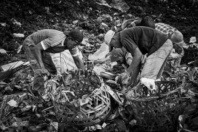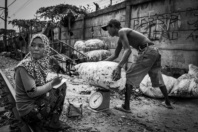Scavengers work under radar to help reduce waste
With their soiled shirts and ripped pants, they roam around the city daily. They end their work only after they feel exhausted and return to their small rented room in a house in Menteng, Central Jakarta, where eight other families of scavengers also have rooms.
If they are lucky, they are able to collect 14 kilograms of waste, which means they can pocket Rp 50,000 (US$3.50) from the garbage collector. “That’s not a lot. But we try to be grateful,” said the 35-year-old Aziz, who came to Jakarta from Cilacap in Central Java 22 years ago. The great deal of adversity they faced had even evoked the thought of selling their child for money. “But we’re advised [by other scavengers] not to and we began to think she may have a better future.” There are about 25,000 scavengers in Jakarta and its surrounding area, according to the Indonesia Scavengers Association (IPI). Many of them are stationed at the Bantar Gebang dump site in Bekasi, West Java, where Jakarta’s 7,400 tons of waste are disposed daily.
Annually, the capital produces 2.5 million tons of waste, 357,000 of which is plastic. Not all of the waste can be dumped at Bantar Gebang, the only landfill for Jakarta’s waste, which is to reach full capacity in 2021. Some of the untreated waste pollutes the city’s rivers and ends up becoming marine debris.
Data from the city’s environment agency reveals that the accumulation of plastic waste in Jakarta’s rivers has created a layer of sediment 50 centimeters thick, which can cause floods. “Plastic is our money so we do anything for it. I don’t mind having to dive into a gutter to collect it ; Azis. “We sometimes go to places the orange troops do not reach,” he added, referring to the city’s official team for cleaning up waste.
The efforts of the scavengers are important to help the city sort the types of waste. Although the administration has launched a waste bank program, which encourages residents to collect waste and sort it based in exchange for money, it has yet to gain popularity citywide.
Scavengers work under radar to help reduce waste
With their soiled shirts and ripped pants, they roam around the city daily. They end their work only after they feel exhausted and return to their small rented room in a house in Menteng, Central Jakarta, where eight other families of scavengers also have rooms.
If they are lucky, they are able to collect 14 kilograms of waste, which means they can pocket Rp 50,000 (US$3.50) from the garbage collector. “That’s not a lot. But we try to be grateful,” said the 35-year-old Aziz, who came to Jakarta from Cilacap in Central Java 22 years ago. The great deal of adversity they faced had even evoked the thought of selling their child for money. “But we’re advised [by other scavengers] not to and we began to think she may have a better future.” There are about 25,000 scavengers in Jakarta and its surrounding area, according to the Indonesia Scavengers Association (IPI). Many of them are stationed at the Bantar Gebang dump site in Bekasi, West Java, where Jakarta’s 7,400 tons of waste are disposed daily.
Annually, the capital produces 2.5 million tons of waste, 357,000 of which is plastic. Not all of the waste can be dumped at Bantar Gebang, the only landfill for Jakarta’s waste, which is to reach full capacity in 2021. Some of the untreated waste pollutes the city’s rivers and ends up becoming marine debris.
Data from the city’s environment agency reveals that the accumulation of plastic waste in Jakarta’s rivers has created a layer of sediment 50 centimeters thick, which can cause floods. “Plastic is our money so we do anything for it. I don’t mind having to dive into a gutter to collect it; Azis. “We sometimes go to places the orange troops do not reach,” he added, referring to the city’s official team for cleaning up waste.
The efforts of the scavengers are important to help the city sort the types of waste. Although the administration has launched a waste bank program, which encourages residents to collect waste and sort it based in exchange for money, it has yet to gain popularity citywide.















